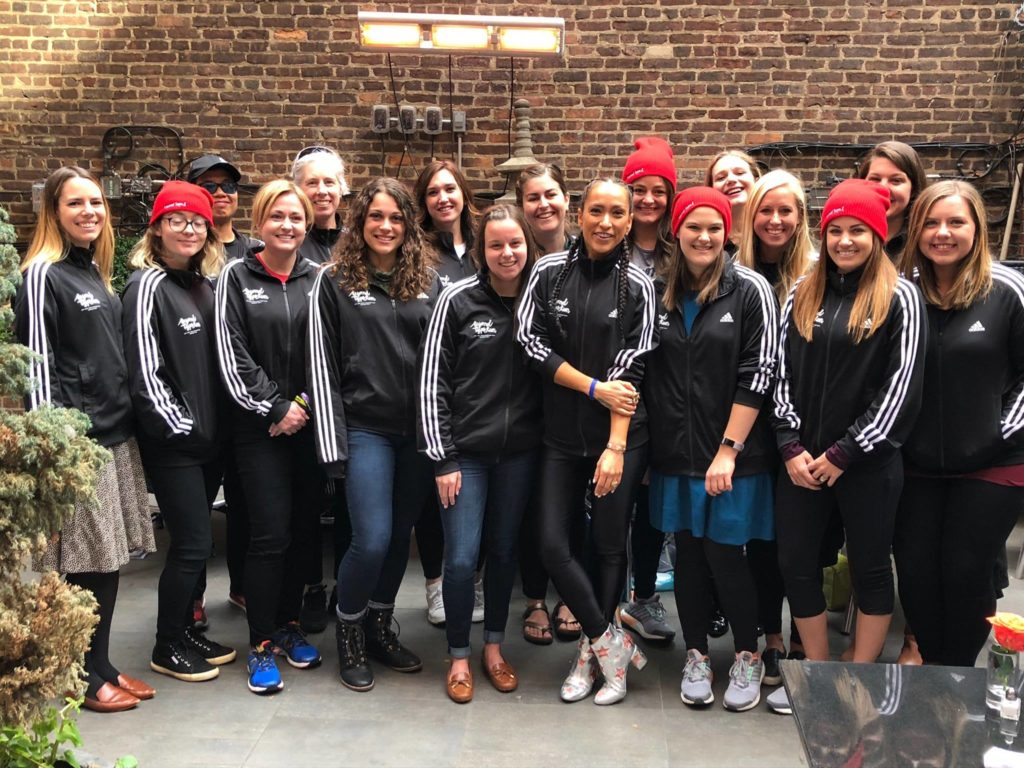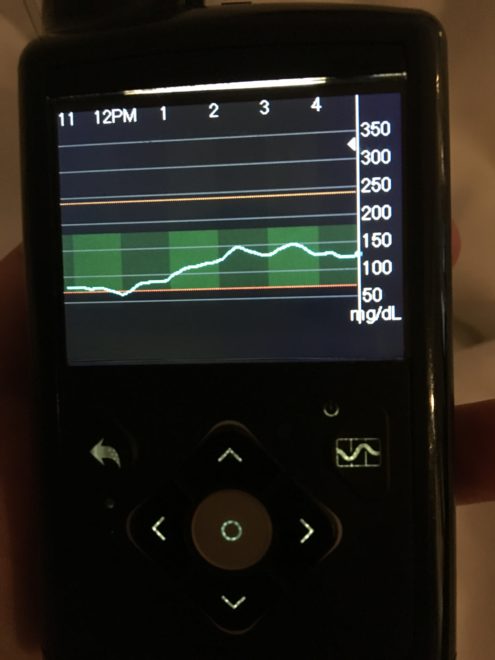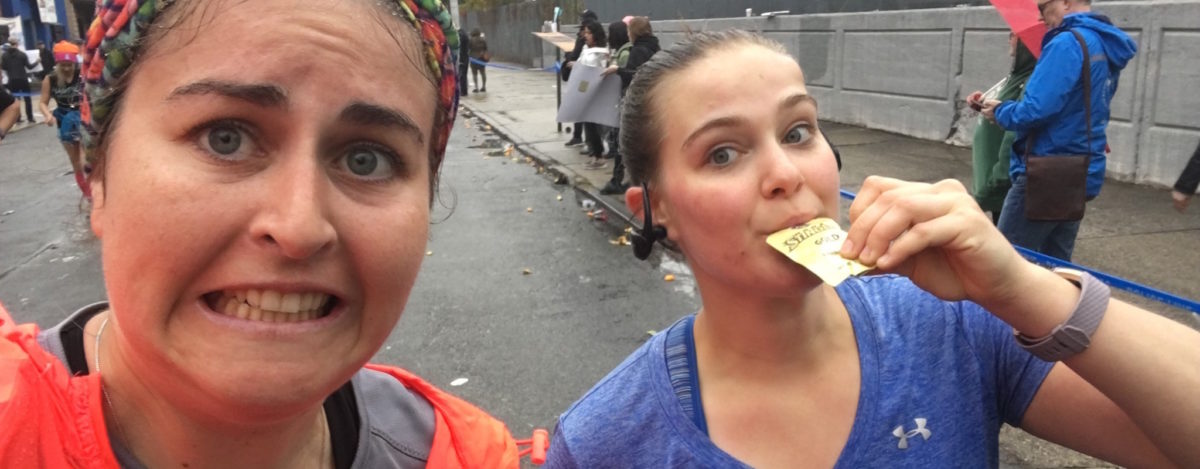Pre-Marathon Nightmares to Amazing Race Day BGs
Editor’s Note: Julie was a member of Beyond Type Run‘s 2017 TCS New York City Marathon Team sponsored by Medtronic Diabetes. Learn more about the 2019 Beyond Type Run team here.
My family was a little surprised when I ran the idea of running the TCS New York City Marathon by them last February. Perhaps because I was not a runner, they didn’t think that anything would come out of my hasty idea. They had a point; although I loved doing anything I could that was active and outside, running was the one activity I avoided at all costs. To me, I perceived that running would cause my type 1 diabetes to go into havoc. I imagined myself laying on the side of a road or trail, miles from food, with a blood glucose level too low to stand because of the rigorous activity. Although I’ve done long-distance bicycle tours and climbed peaks in the rockies, running was the activity I didn’t think I was capable of doing.
However, the Beyond Type Run marathon team sparked my interest because I wouldn’t only be running for myself—this opportunity entailed running on a team of people with type 1 diabetes while advocating for education, visibility and inspiration in the type 1 community. One of Beyond Type 1’s charges is to #livebeyond one’s diagnosis and shatter perceived limitations, of which I wholeheartedly agree. I decided that if I wanted to embody that mentality, I needed to push myself beyond my own perceived limitations. I needed to run this marathon.
I applied and was accepted to the team about a month later, and marathon finish lines started to cloud my dreams. They weren’t all good dreams, as I was constantly questioning my ability throughout training. One night, I dreamed that I arrived at the start line wearing only Birkenstocks on my feet. Although we were only connected online, the 17 runners on the team began sharing experiences throughout the training and fundraising process, and this support was essential to my belief that I could succeed. We shared accomplishments as we had them, such as completing long runs or having motivating interactions with people in our community.
We also would share struggles along this journey. I got very sick around late September, and was trying to find any way to push through a terrible chest cold when an 18 mile long run was in the training plan. I was hardly able to walk around my apartment, and I was feeling really down and unsure for the future of my training. My team immediately responded with encouragement and reassurance that resting was the best thing I could do. They helped me push through those emotional couple of weeks, and I can attribute my perseverance through my own insecurities to the amazing team I was on.
Many of the team also transitioned onto the MiniMed 670G system in the midst of heavy training. There was no shortage of helpful advice in our group as we used the SmartGuard technology features of this pump to create and practice our unique race-day strategies for blood glucose control.* I learned how soon before a run to start a temporary target of 8.3 mmol/L150 mg/dl to avoid low blood glucose reactions, and when to conclude my temporary target to mitigate post-workout high blood glucose reactions.* I used aspects of both Auto Mode and Manual Mode with temporary basal rates for my weekly long runs, and was able to maintain very tight blood glucose control during these runs using this strategy. The MiniMed 670G gave me peace of mind throughout training and heading into the unknown factors of race day.

Marathon weekend arrived, and our team finally got to bond in person. In addition to our team brunch, we spent about four hours together in the start village waiting for our start time. Many of us were not accustomed to such a late (11 a.m.) start time. I took advantage of the features and flexibility of my MiniMed 670G to set my blood glucose up for the best possible marathon experience despite the unusual start time. I used a temporary target feature in Auto Mode to set my target blood glucose for 8.3 mmol/L150 mg/dl starting the night before the marathon. In addition to careful timing of food and insulin dosage, I was able to start my marathon around 12 mmol/L210 mg/dl with less than a unit of insulin on board. I knew that insulin would drop me quickly, after which my fueling plan for the race would take over. I set my temporary basal rate in the start corral and before we knew it, the cannon went off. I knew that my desire to not allow diabetes to hold me back, the support from the community and the latest technology, would all play a key role in my success.
The marathon itself was a whirlwind experience. The NYC Marathon truly is a 26 mile block party, with people cheering along the entirety of the route. With 50,000 runners participating, I was surprised to run with many of my teammates at different points of the race. A particularly memorable moment was crossing the halfway point with my teammate Stephanie, while both of us were trying to raise our blood glucose through different fueling methods. I was also thrilled to start and finish the marathon with Beyond Type Run teammates. So often with type 1 it is easy to feel alone, and although this was an incredible individual victory for all runners, this was also a team accomplishment and a victory for the type 1 community. Seeing Beyond Type 1 members, Medtronic employees, family and friends all cheering us on reminded me that we were running for so much more than ourselves.

Amazingly, my blood glucose stayed between 3.5 and 5 mmol/L65 and 91 mg/dl from miles 3-18, and I finished the marathon around 7.8 mmol/L140 mg/dl. Thanks to the SmartGuard technology in my MiniMed 670G, I even stayed in range the entire night after the marathon while I slept, waking up with a diabetic “unicorn”—a perfect 5.5 mmol/L100 mg/dl blood glucose! Many factors contributed to my blood glucose management success, including having my continuous glucose monitor (CGM) sensor data at my fingertips, the use of the suspend option and temporary basal rates, consistent fueling and most of all, practice and training leading up to the run. At no point during the marathon or training did I find myself incapacitated by low blood glucose, as I had imagined. This experience taught me that with careful preparation, even running long distances is possible. But more importantly, it taught me that this was about more than me and 16 other runners accomplishing 26.2 miles. This was a reminder that all people with diabetes are capable of more than they believe. No matter what your dreams may be, whether it be to cross a finish line or graduate with honors, you can accomplish BIG goals with the help of our supportive community.
All I can think of now is, “What next?”
Important Safety Information
*Individual results may vary. CAUTION: the MiniMed 670G system depends on, and is not a substitute for, finger stick measurements using a blood glucose meter. Sensor glucose values generated by the system approximate but are not the same as blood glucose values determined by a blood glucose meter.
The Medtronic MiniMed 670G system requires a prescription and is intended for continuous delivery of basal insulin (at user selectable rates) and administration of insulin boluses (in user selectable amounts) for the management of type 1 diabetes mellitus in persons, 14 years of age and older, requiring insulin as well as for the continuous monitoring and trending of blood glucose levels in the fluid under the skin. The MiniMed 670G System includes SmartGuard technology, which can be programmed to automatically adjust delivery of basal insulin based on continuous glucose monitor sensor glucose values, and can suspend delivery of insulin when the sensor glucose value falls below or is predicted to fall below predefined threshold values.
WARNING: Do not use Auto Mode for a period of time after giving a manual injection of insulin by syringe or pen. Manual injections are not accounted for in Auto Mode. Therefore, Auto Mode could deliver too much insulin. Too much insulin may cause hypoglycemia. Consult with your healthcare professional for how long you need to wait after a manual injection of insulin before you resume Auto Mode.
The Guardian Sensor (3) is not intended to be used directly for making therapy adjustments, but rather to provide an indication of when a finger stick may be required. All therapy adjustments should be based on measurements obtained using a home glucose monitor and not on values provided by the Guardian Sensor (3).
Pump therapy is not recommended for people whose vision or hearing does not allow recognition of pump signals and alarms. Do not use the serter on products other than the Enlite sensor or Guardian Sensor (3). Medtronic cannot guarantee the safety or efficacy of this product if used with other products. The reservoir is contraindicated for the infusion of blood or blood products. Infusion sets are indicated for subcutaneous use only and not for intravenous (IV) infusion or the infusion of blood or blood products. Insulin pump therapy is not recommended for those who are unwilling to perform at least four blood glucose tests per day. As insulin pumps use rapid acting insulin only, blood glucose (BG) testing is required to help identify rapid glycemic deterioration due to insulin infusion occlusion, infusion site problems, insulin stability issues, user error, or a combination of these. Pump therapy is not recommended for people who are unwilling or unable to maintain contact with their healthcare professional.
The safety of the 670G system has not been studied in people with impaired kidney function. Please let your healthcare professional know if you have kidney disease so you and your healthcare professional can determine if the potential benefits of using the system outweigh the risks. The safety of the 670G system has not been studied in pregnant women, people with type 2 diabetes, or in people using other anti-hyperglycemic therapies apart from insulin. Please let your healthcare professional know if any of these conditions apply to you so you and your healthcare professional can determine if the potential benefits of using the system outweigh the risks.
For complete safety information, please consult the appropriate User Guide.
Read about Julie’s training for the TCS New York City Marathon in Dear Little Purple Pancreas.
To learn more about the 2019 TCS New York City Marathon Beyond Type Run team here.





